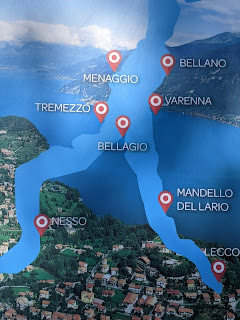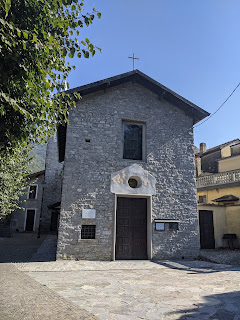The railway station building in Lugano was constructed in 1875, one year after the Lugano-Chiasso line opened. When the Gotthard railway line was completed in 1872, the station was on one of the main transport routes between northern and southern Europe. A cable railway, the first built in the canton of Ticino, provided a link with the city center beginning in 1886.
This Daily Travelogue is a labor of love for our families and friends at home and around the world. Prior to 2020, all our trips were documented on separate, yearly blogs which can be accessed below. Remember that clicking on any picture will open it for better viewing. Also, please consider adding your name at the end of any comments. Be safe, stay healthy, and stay connected.
Monday, November 15, 2021
10/10/21: Lugano, Switzerland-Lake Como's Varenna, Italy
We spotted a number of rowers on Lake Lugano.
Just past Gandria, the small town we had taken a boat to the day before, was the border with Italy. When the bus driver just sailed through en route to Menaggio where we were getting a ferry to the Lake Como town of Varenna, Steven and I looked at each wondering why we'd bothered getting a rapid PCR test the day before in Lugano that we thought was required for admission into Italy. Oh well, we felt we did the right thing even if it did cost us $100 for both.
The road was so narrow, the bus driver had to sound his horn that sounded like a foghorn when approaching the many curves. He got behind a number of cyclists but had no space to pass them. It seemed like a treacherous place to cycle with cars and buses traveling at high rates of speed when they could.
Lago do Como or Lake Como was one of the lakes in the picturesque Italian lakes district that we were going to explore for the next three nights while using the village of Varenna as our base.
The ferry approaching Menaggio on the northwest side of the lake:
We didn't spend any time in attractive-looking Menaggio after the bus dropped us off because we had our bags with us and just walked to the ferry port. Thank goodness we didn't dawdle as the ferry for Varenna left just ten minutes after we arrived.
Saying arrivederci Menaggio ...
and buongiorno Varenna on the opposite side of the lake!
More views of southern Lake Como that we'd see in the next couple of days:
Varenna is just a village of 800 people but is enormously popular with tourists because of its striking location on the lake. We'd rented a room at a B&B which was all of two minutes on foot from the tiny harbor and therefore so handy when lugging duffle bags. I found the room almost claustrophobically small but took comfort in the fact we wouldn't be spending much time there. The complimentary bottle of wine was a nice touch, though. Unfortunately, the breakfast room was off-limits except at breakfast which was a shame.
The tiny Esino River:
Hotel Olivedo on the ferry dock has been serving ferry passengers since the late 19th century. It was named for the olive trees growing up the hillside, the farthest north that olives grow in Europe, by the way.
Lucia was an old traditional boat that allowed men to row standing up. The frame supported a canopy that provided some shelter when fishing at night using nets. Hint: Remember the Lucia name!
One of the most delightful things we discovered in Varenna was the elevated lakefront promenade that was built a generation ago to connect the dock and the old town.
Looking back, we could see and hear another of the constant ferries that connected the towns along the lake.
The small community harbor:
One of the countless stepped lanes in Varenna called contrade - a cafe on the passerella or promenade had kindly placed cushions for people to enjoy their treats from a softer perch!
The original arches covered arcades with chestnut beams.
A particularly colorful contrade:
Patrons staying at the Hotel du Lac had a lovely view from the terrace to dine or drink!
Away from the harbor was Piazza San Giorgio, the town square that was the village's former market square.
On one corner of the piazza or square was the Church of San Giovanni Battista or St. John the Baptist that dated to the 11th-century on the site of a previous Christian building. It was expanded in 1151, re-consecrated in 1331, and restored in 1964-67. We were incredibly lucky to find the church open as it rarely was.
It was during the restoration that 14th-century frescoes were discovered. The frescoes in the apse were from the beginning of the 16th-century, though.
It was a little odd seeing a hotel in tiny Varenna named The Royal Victoria until we learned that the queen had visited in 1839 but had registered herself as the Countess of Clare to try and remain anonymous.
Unless I'd read about it, I would never have known that the plane trees planted on the square were in the shape of a 'V' for Varenna.
At the top of the square was the 13th-century Church of San Giorgio with a fresco of St. Christopher, the patron saint of travelers on its facade. I could imagine how the image would have welcomed visitors starting in the 1300s.
The black floor and chapels had been made using local marble.
Symbols on the exquisitely carved walnut confessional reminded worshippers that even in death, all of us are equal.
The 14th-century fresco on the back wall, which made the horrors of hell extremely real, was created at the same time as Inferno was written by Dante.
Seeing this stunning view of the lake from Villa Monastero goes a long way to understanding the spell Lake Como has long held over its visitors. The villa was one of many 19th-century villas that lined the lake and, because the lake was protected from the north wind, exotic flowers grew in many of the gardens.
We toured the grounds of the villa that was the former residence of the De Marchi family but not their residence which was filled with furnishings from the late 1800s. At the same altitude as Boston, palm trees and oranges could grow. The most common tree in the villa's garden was the Italic cypress which lined the upper boundary for almost two km!
Also present in the gardens were Chinese palms and St. Peter's palms and the rare, for Italy, the Chilean palm which had a circumference of four meters. Other rare palms included the Blue palm of Mexico with leaves up to 2.5 meters long and Guadalupe palms that had fruit weighing up to 30kg!
Part of the villa:
I wouldn't object to being winded and dined on the villa's terrace anytime!
The villa's citrus garden included lemons, clementines, kumquats, and mandarins.
From the gardens we hiked on a long steep and stony path to Castello di Vezio or Vezio Castle, Varenna's ancient hilltop castle located in the nearby hamlet of Vezio.
Through the trees we caught a view of Lake Como.
We could tell Vezio was really small as it had just a single chapel!
Sculptures just before the entrance to the castle:
Lake Como is not only the deepest lake in Europe at 418 meters but it also has the longest shore of any Italian lake at 170 km and is also the third largest in surface area and volume. Although Lake Como has provided a welcome escape for the uber-rich and minor royals since Roman times, it was 'put on the map' by The Betrothed, considered to be the most famous and widely-read Italian novel and written by Alessandro Manzoni in the mid-19th century. After the novel's protagonist was named Lucia, the lake's characteristic rowing boat adopted her name as I pointed out above.
More delightful views of the lake and its Bellagio Peninsula from the castle overlook:
When I wrote the path to the castle was long and steep, I wasn't exaggerating as here were Varenna's rooftops far below us!
A sign at the castle proclaimed that olive cultivation here at the 49th parallel was possible at this northernmost point because the lake's enormous body of water generates a sizeable "thermal flywheel effect" while the wall of the Alps provide a screen against the cold, northerly winds. Olive cultivation began at Lake Como 2,000 years ago by the Romans who planted olive groves on hilltops and slopes up to an altitude of 500 meters. They produced oil as a precious foodstuff, and as a lamp fuel which was traded far and wide. The most ancient tree in the area is thought to be 450 years old, meaning it has survived historic freezes and recovered to still be productive.
I read that the origins of Castle Vezio are unclear but Vezio is probably of Roman origin based on the Roman families who had the same name who were also living in the Como area.
Steven was not happy with my dawdling taking this picture of him atop the wobbly drawbridge. I couldn't blame him when I walked on it a few minutes later!
The views were definitely the main draw at the castle!
I didn't wait for Steven to take a picture of me on the same bridge as I just wanted to get off it right away, too!
An unusual art installation ...
and another in the same style!
We had timed our visit to arrive at the castle by 3 in time for what was supposed to have been a falconry show on the parklike terrace only to learn that there had been none since Covid began. A few birds of prey were 'normally' chained to the stakes here. I wonder when time will return to 'normal' again, don't you?!
Artu was an Eurasian eagle owl.
The last of the ghostly figures!
Next post: Hiking the Wayfarers' Path from Bellano to Varenna.
Posted on Novemeber 15th, 2021, from Positano, Italy, shortly after returning from the Greek and Roman ruins at Paestum on the Almafi Coast Drive, described as one of the most stunning coastal drives in Europe. I'll also add nervewracking for its nonstop hairpin turns!
Labels:
Italy
Subscribe to:
Post Comments (Atom)





































































































Lake Como, set against the foothills of the Alps, really is magnificent !
ReplyDeleteWhat an absolutely delightful area Varenna was, Lina!
ReplyDelete